What Preserved the Art of Altamira Until Modern Day

Cave of Altamira entrance
© Museo de Altamira. Photo M. Otero
The Cavern
The cave of Altamira, located near the town of Santillana del Mar in Cantabria, northern Spain, was declared a World Heritage Site by UNESCO in 1985.
This region was occupied past Upper Palaeolithic groups for millenia; indeed, the groups formed a cultural order, using this and other nearby caves such as La Clotilde, El Linar, Las Aguas, Cualventi, La Meaza, Cudón, El Castillo, La Pasiega, Las Chimeneas, Las Monedas, Hornos de la Peña, Morin, El Pendo, Santián, El Juyo, Camargo, and El Ruso, amongst others.
The cave of Altamira, with its twisting passages and chambers, is roughly 270 metres. The main passage is at times six metres in height. Archaeological excavations in the cave take revealed Palaeolithic artifacts from the Gravettian (roughly 22.000 years ago) to the Center Magdalenian (between roughly 16.500 and 13.000 years ago).
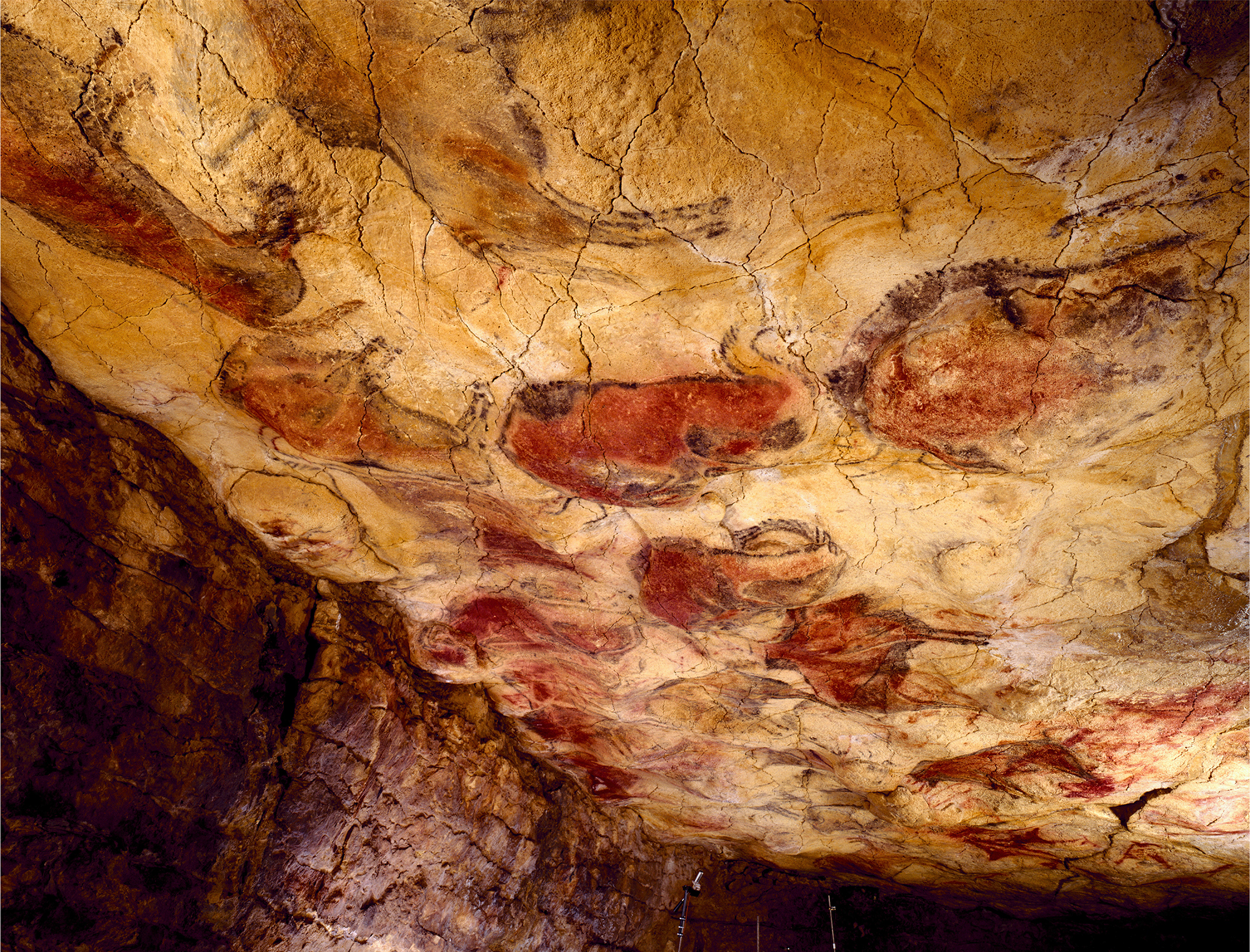
© Museo de Altamira. Photo P. Saura
The cave was inhabited past unlike groups of people between these 2 periods. The location of the cave was clearly favourable for occupation, with a mural of valleys and mountains as well every bit the nearby coastal region. Roughly 13,000 years agone a stone fall sealed off the cave'south archway; Altamira remained sealed until its rediscovery in 1868.
Whilst human occupation but occurred at the cave mouth, the painting, drawing and engraving took place throughout the cave. The artists used ochre and charcoal. Equally with other Palaeolithic artists, they used the natural contours of the cave walls to heighten the polychrome depictions; the contours may have inspired a particular depiction, or the artists may have been using this technique to provide a 3-dimensional element to the art. The art of Altamira encompasses naturalism, abstraction and symbolism.
The Cave Art
The paintings and engravings of Altamira were begun during the Aurignacian menstruation, the starting time chapter of Upper Palaeolithic art in Europe. The art was created over a period of 20,000 years, between 35,559 and fifteen,204 cal BP. The cave was re-used repeatedly, with artists either respecting and avoiding existing depictions, or adding to them and using them in new figures. We are left with a spectacular Palaeolithic palimpsest. The art throughout the cave of Altamira is impressive, simply on the ceiling of the Hall of the Paintings it becomes truly spectacular.
The Ceiling with the Polychrome Bison
This is the primary attraction and interest of Altamira. The 25 big polychrome figures draw bison, a hind and two horses. They are between 125 and 170cm in length, while the hind is ii metres. The figures were produced by engraving and cartoon the outlines. Greater detail was achieved past deeper engraving. Most of the figures were then filled with cherry-red paint obtained from ochre, although some were painted with yellow or brown paint, again obtained from ochre. In several figures, black pigment was used for shading. The use of colour to capture anatomy was highly selective; to divide the legs from the chest, the haunches from the belly, then on.
The natural protuberances on the ceiling were employed for perspective and volume (No. 34, 35, 36, 39, 50). Cracks were also used to stand for outlines (No. 34). This grand composition is completed with the large head of a horse (No. 41) with the figure of a foal (no. 46).
The Ceiling of the Red Horses
This is the oldest stage in the decoration of the main ceiling, with animals painted in cherry, engraved signs, hands and several serial of dots. Xi large (betwixt 150 and 180cm in length) red figures, more often than not horses, were originally dispersed across a large part of the ceiling. None of them include any relief or other natural forms of the ceiling.
Well-nigh the Hall of the Paintings a very narrow side-passage is decorated with crimson signs. One sign consists of iv irregular ovals divided upwards internally. Some other sign, iii metres in length and formed by long red bands of parallel lines crossed past pocket-size transversal lines, is tucked nether an inaccessible rock prominence.

Bison
The ceiling with the Polychrome Bison
© Museo de Altamira. Photograph P. Saura
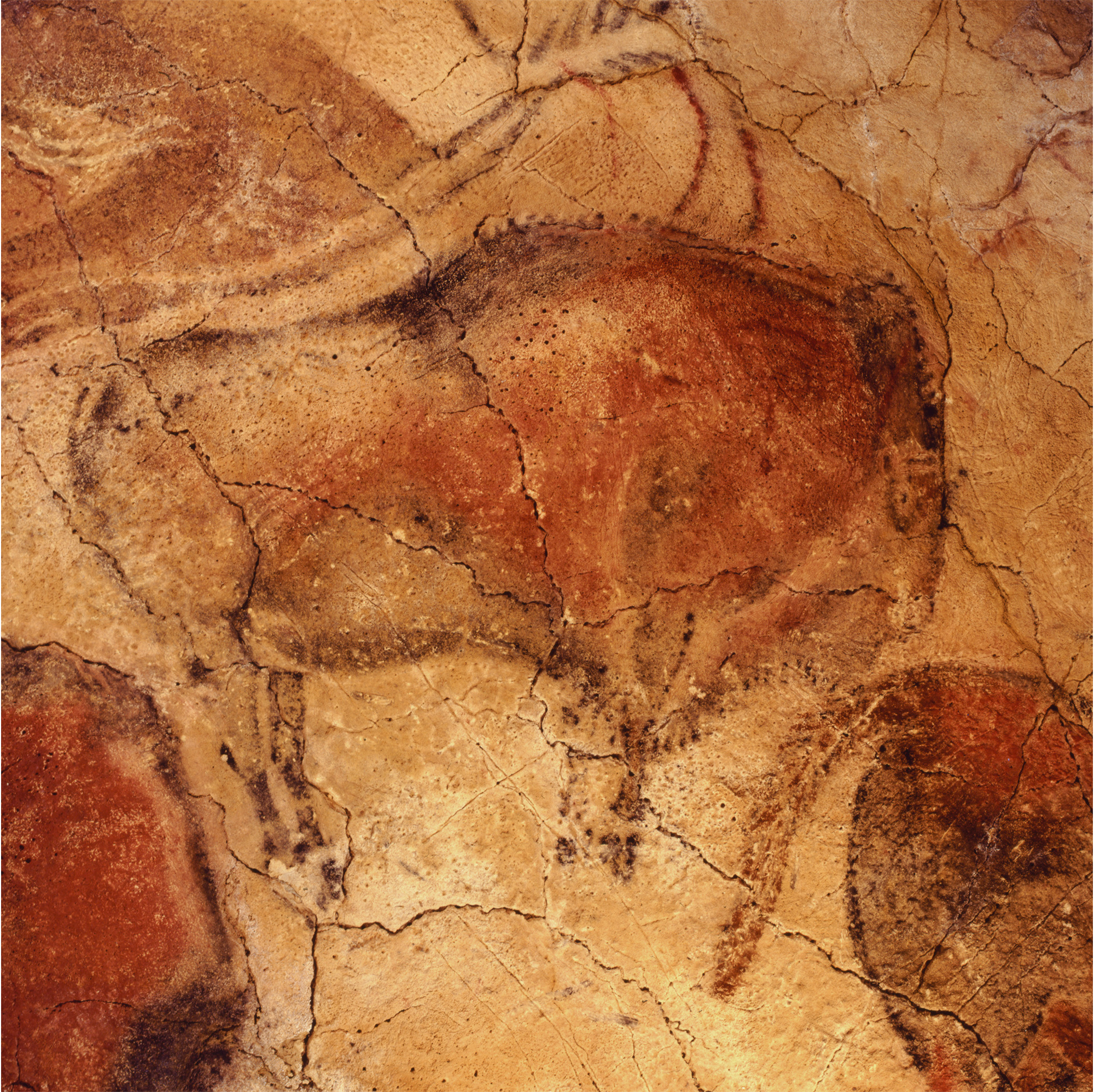
Bison
The ceiling with the Polychrome Bison
© Museo de Altamira. Photo P. Saura
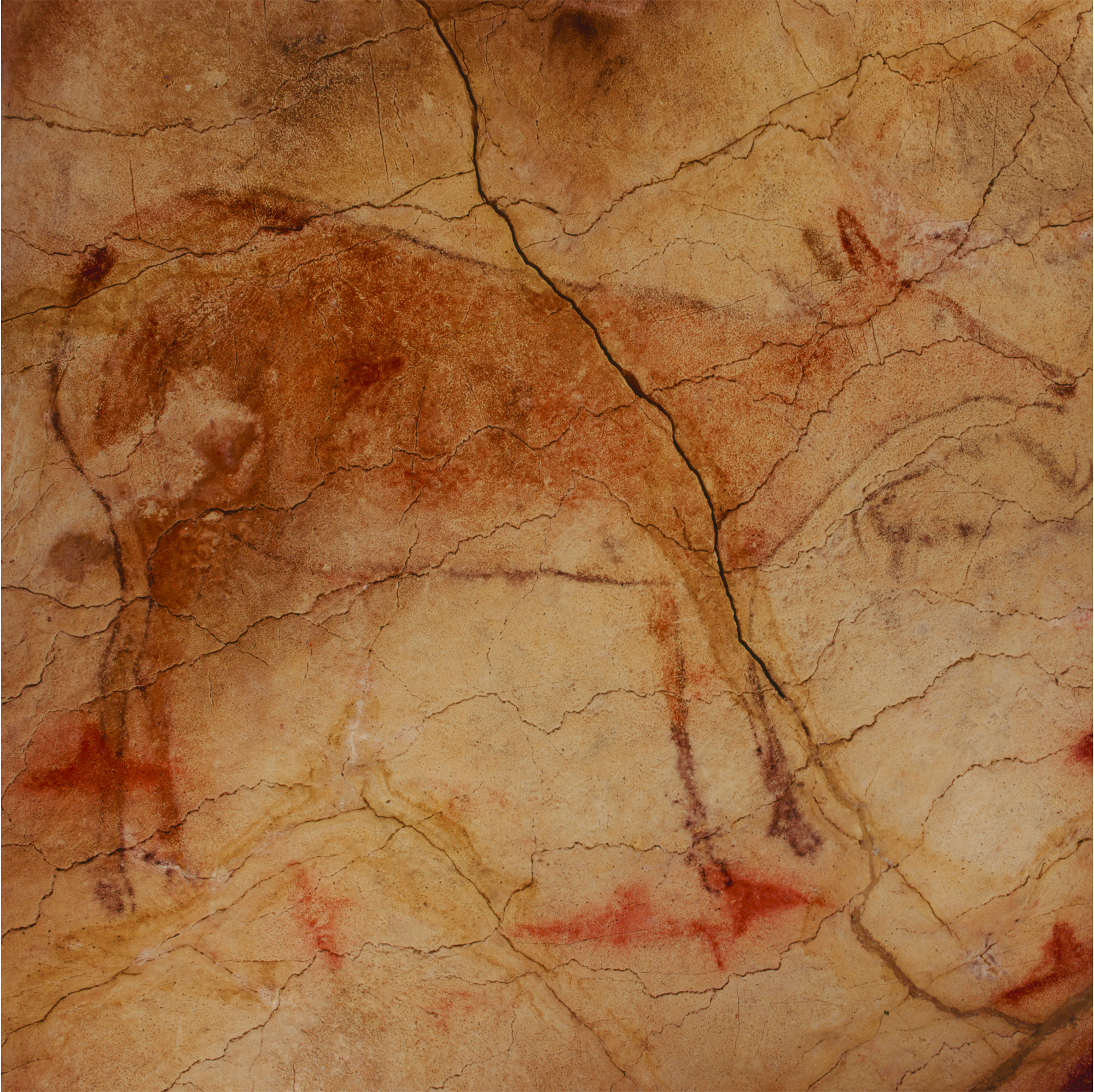
Hind
The ceiling with the Polychrome Bison
© Museo de Altamira. Photograph P. Saura
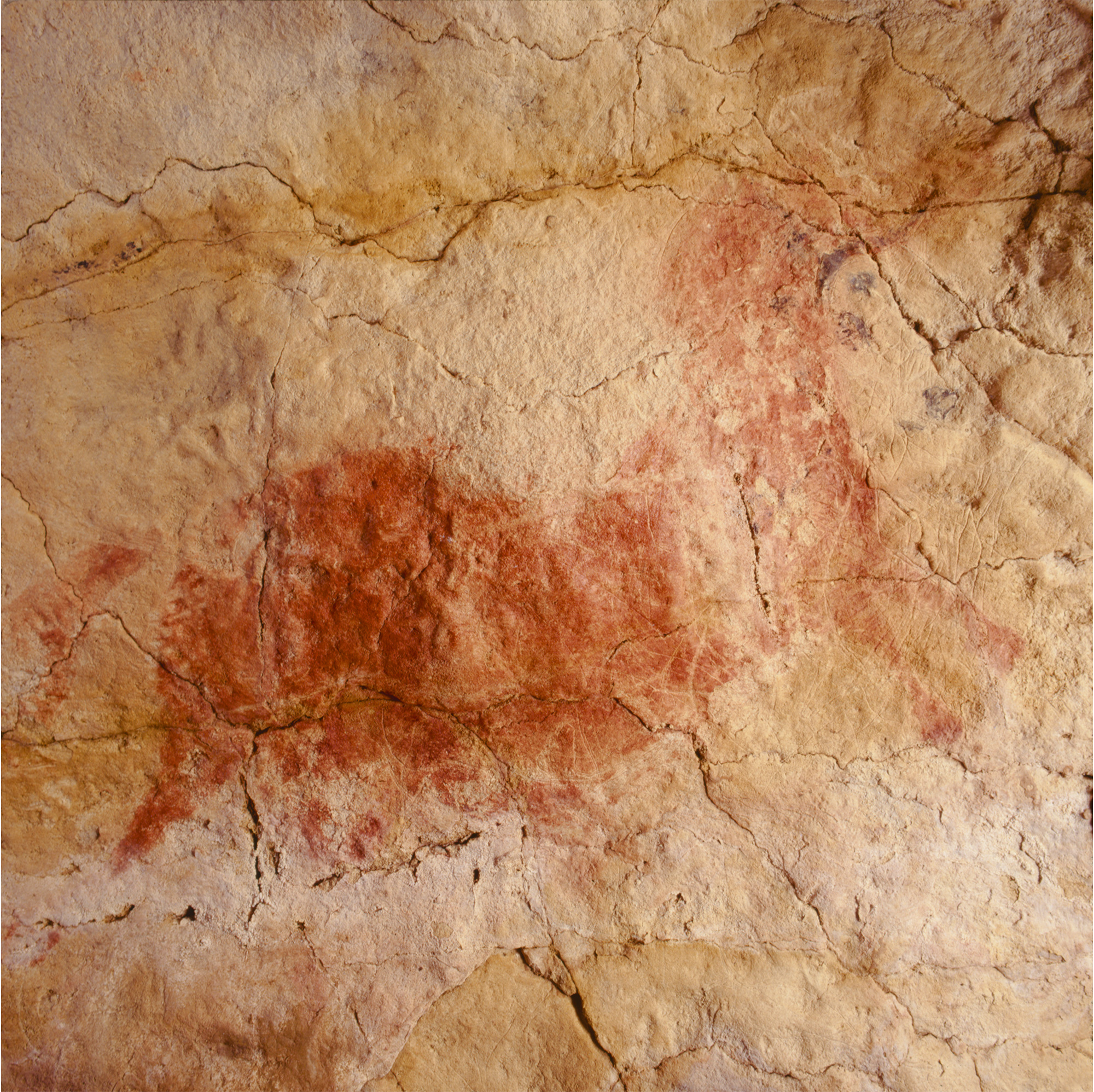
Red horse
The ceiling of the Red Horses
© Museo de Altamira. Photo P. Saura
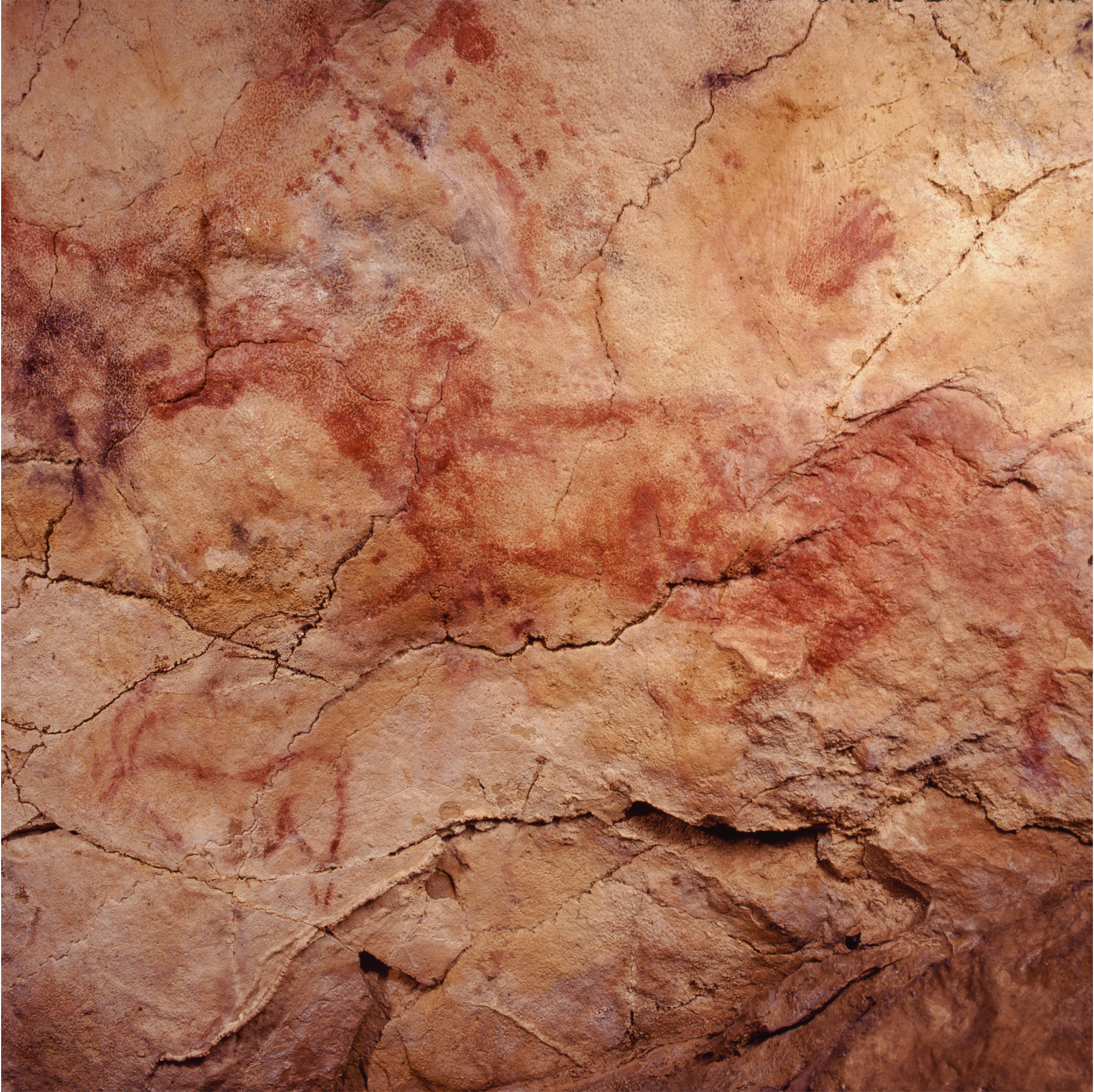
Ruddy equus caballus
The ceiling of the Ruddy Horses
© Museo de Altamira. Photo P. Saura
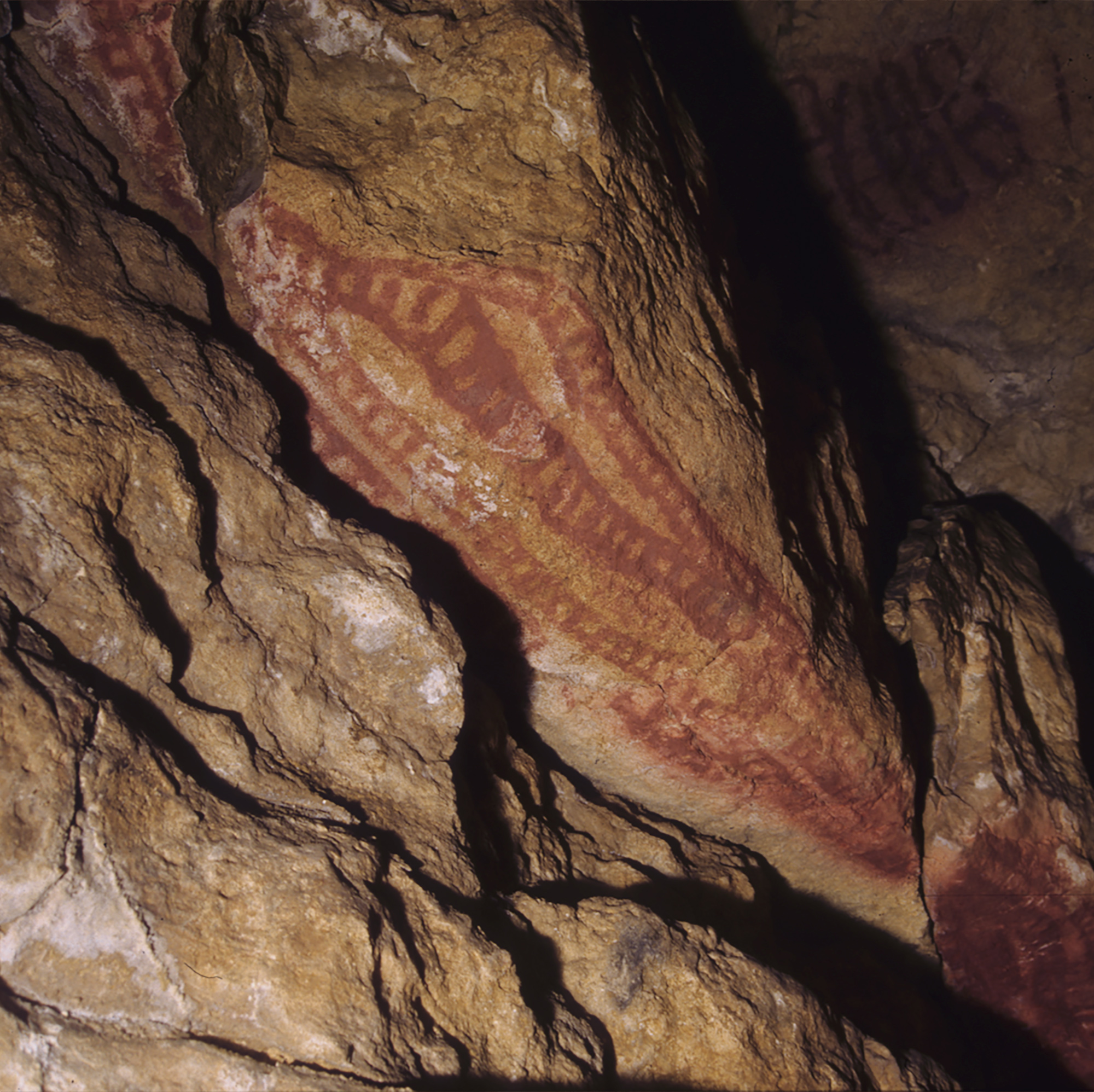
Red sign
The ceiling of the Red Horses
© Museo de Altamira. Photograph P. Saura
Magdalenian Black and Engraved Figures
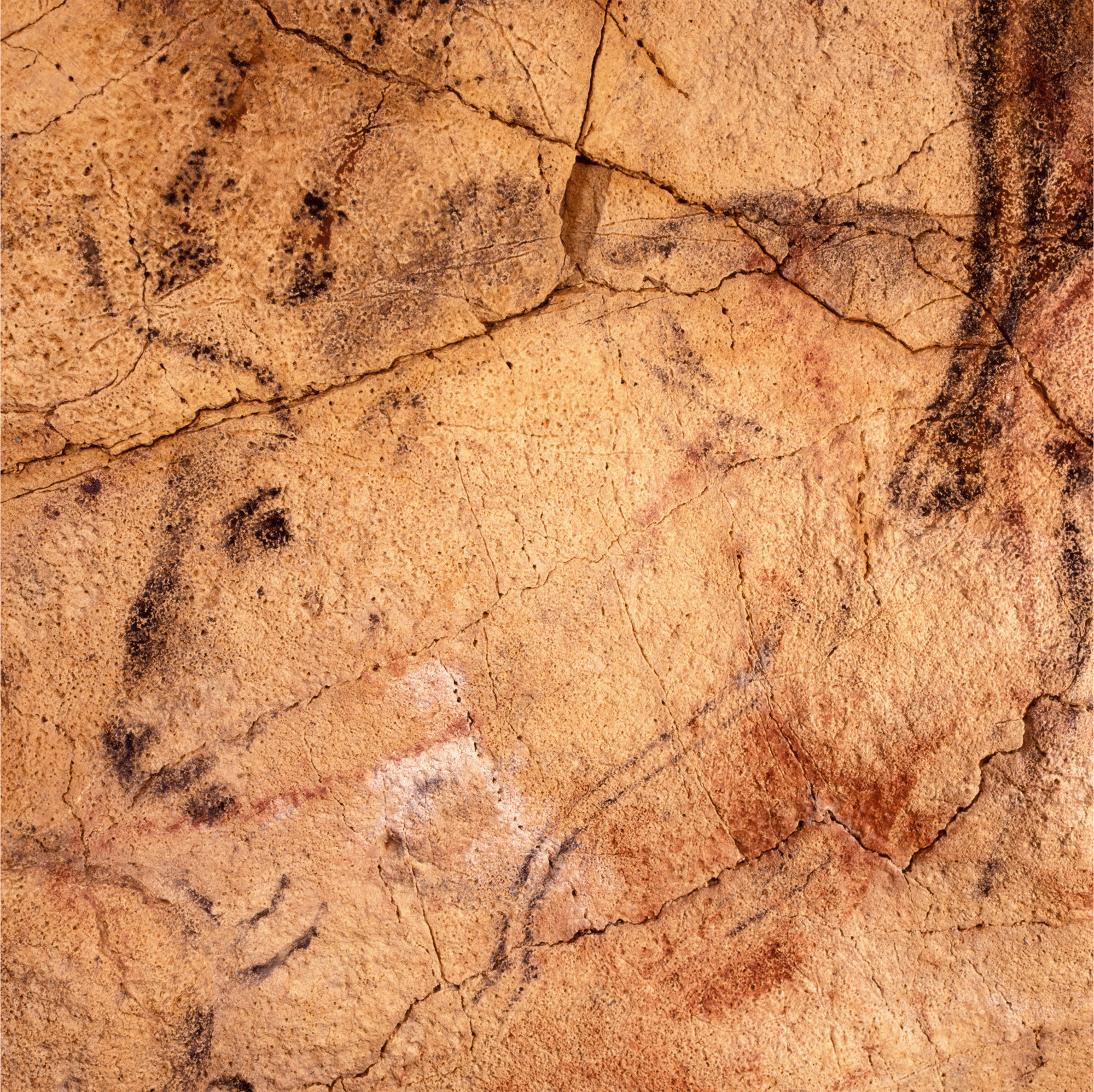
© Museo de Altamira. Photograph P. Saura
All of the blackness figures in Altamira were drawn with charcoal. This has allowed some of them to be dated past AMS radiocarbon. The historic period - Lower Magdalenian - together with certain stylistic and technical uniformity (charcoal as the pigment and a linear style) suggests they are belong to the aforementioned ensemble, even though they were probably created at dissimilar times.
Themes in Magdalenian art are varied; horses, aurochs, bison, ibices, red deer stags and hinds, semi-human faces and signs.
There are only four aurochs in Altamira, only all with similar styles. On the main ceiling, a large bull measuring almost 3 metres in length is partially hidden under a polychrome bison. The outline of the forehead and the line of the abdomen follow natural cracks in the rock wall. The dorsal line is a wide charcoal band with numerous engraved marks.
For a depiction of a bison, a natural rock feature becomes the starting point for a composition - a strip of calcite marked in black acts as the horn.
A grouping of quadrilateral black signs in the terminal passage were carbon dated to the Lower Magdalenian (15,440 +/- 200 BP GifA-91185). Nearby, and using natural forms in the rock, human-like faces known as 'masks' were created with a minimal use of marks to propose eyes, eyebrows and mouths.
The Engraved Cave

© Museo de Altamira. Photo P. Saura
Engraved representations are institute throughout Altamira. The red deer is the species most frequently represented with this technique. One large group of engravings seem to belong to the same family.
The Concluding Bison
The date of this monochrome bison (No. xvi) is the well-nigh recent, based on carbon dating - 13,130 +/- 120 BP - and therefore represents the work of the last artists.
Information technology displays an artistic style and way of execution that has matured; a selective application of charcoal, a smudging of the charcoal to achieve shading.
With the collapse of the cave entrance before long after - and the impossibility of re-entering the cave - it is intriguing to wonder how this sacred space would have continued to evolve artistically.
The Discovery
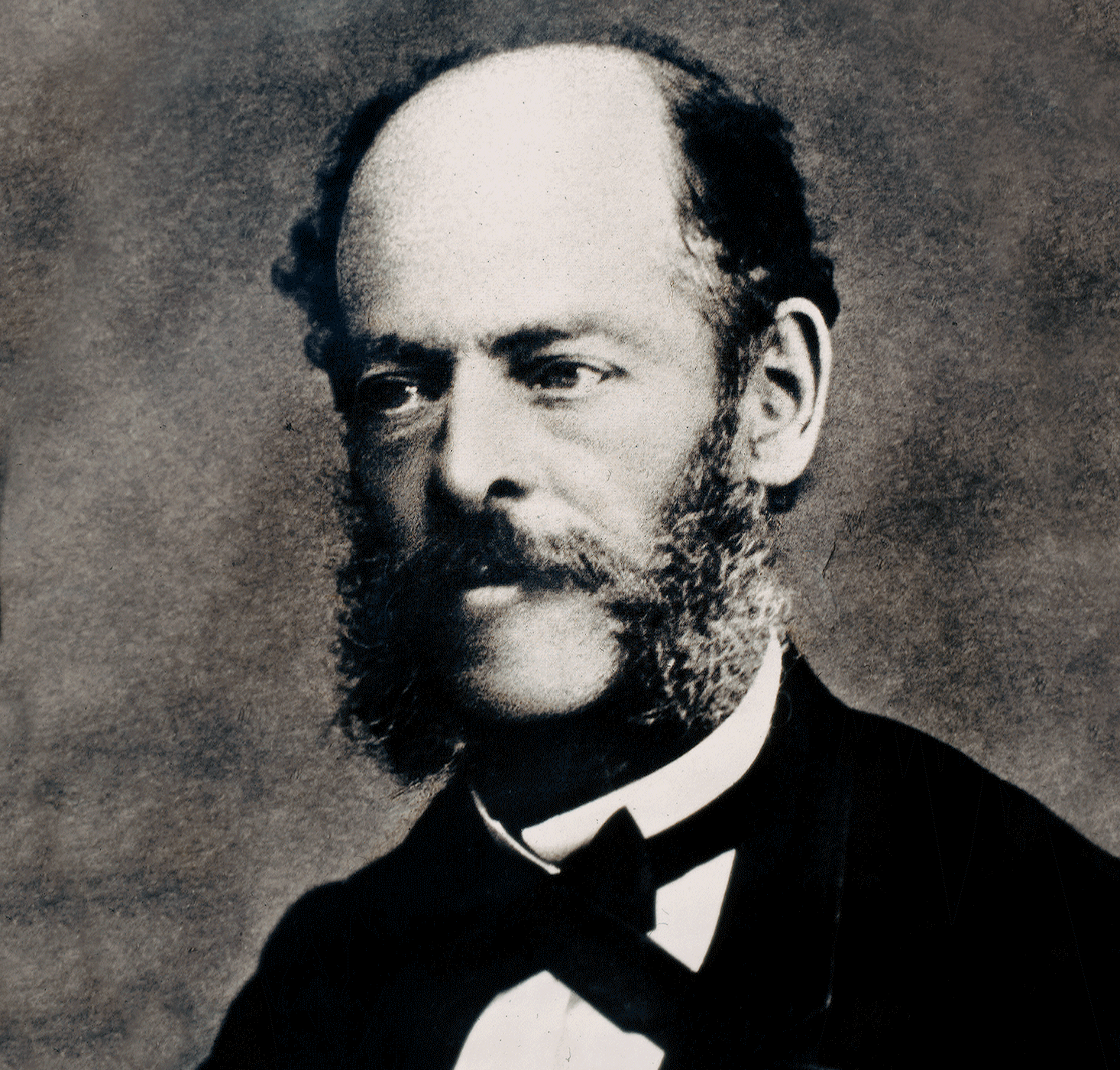
Marcelino Sanz de Sautuola
© Museo de Altamira. Photo P. Saura
"Look, Papa, oxen!" were the words exclaimed by Maria, the daughter of Marcelino Sanz de Sautuola, upon inbound the chamber of the cave.
Having been sealed due to a rock fall, the cave was rediscovered in 1868 by a local hunter. Marcelino Sanz de Sautuola, a local resident who was an apprentice archaeologist, heard of the discovery and visited the cavern in 1875. In 1879 he began exploring the cave in earnest, having become inspired past a recent visit to the 1878 Universal Exhibition in Paris where he had seen exhibits from the Stone Historic period.
The timing here was important - the report of prehistory as a science was in its infancy, and many of the ideas based on the scientific evidence were considered controversial by a lodge entrenched in rigid religious beliefs. To push the creation of art further and further back in time was coming together fierce scepticism on 2 fronts.
Marcelino Sanz de Sautuola, yet, felt certain that the paintings were from the Palaeolithic. In 1880 he published 'Breves apuntes sobre algunos objetos prehistóricos de la provincia de Santander' - 'Brief notes about a few prehistoric finds in Santander Province'.
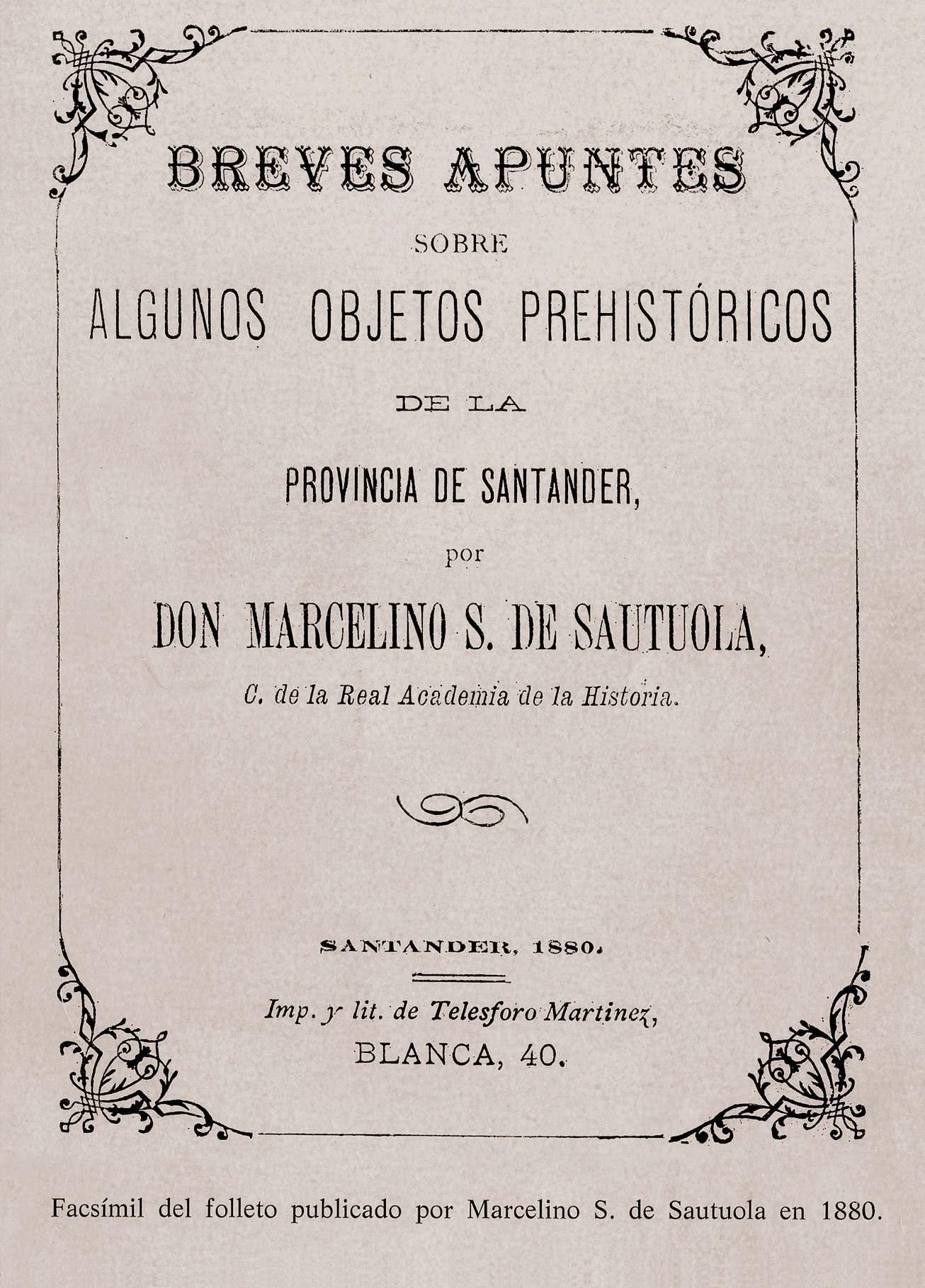
Breves apuntes sobre algunos objetos prehistóricos de la provincia de Santander
Heated debates ensued, not just among leading members of the church building only too amongst prominent archaeologists and prehistorians. Indeed, the paintings in the cave were considered to exist modern forgeries. Whilst the concept of 'the caveman' had become accepted, that same 'caveman' was certainly non sophisticated plenty to produce works of art of this calibre. The fact that the fine art may have been created by women besides as men had not even been entertained.
Public humiliation for Sautuola followed. It was not until 1902, when several other findings of prehistoric paintings had served to return the hypothesis of the extreme antiquity of the Altamira paintings less shocking (and forgery less likely), that the scientific guild retracted the opposition to Sautuola'due south suggestion. That year, the leading French archeologist Emile Cartailhac, who had been one of the leading critics, emphatically admitted his mistake in the famous article, 'Mea culpa d'un sceptique', published in the journal 50'Anthropologie.
Objects found past Sautuola in the cave of Altamira © Museo de Altamira, Photo P. Saura.
Tragically, this vindication was too late for Sautuola, who had died 14 years earlier. Information technology was merely then that his proposal was considered pivotal. The cavern of Altamira was the beginning place in the world where the existence of rock art from the Upper Palaeolithic age was identified.
Its uniqueness and quality, the stunning conservation, and the freshness of its pigments meant its credence would exist delayed by a quarter of a century. At the time, it was a scientific anomaly, a discovery that constituted a giant bound and not an incremental step, and the phenomenon was difficult to understand for the guild of the nineteenth century, gripped by extremely rigid propositions.
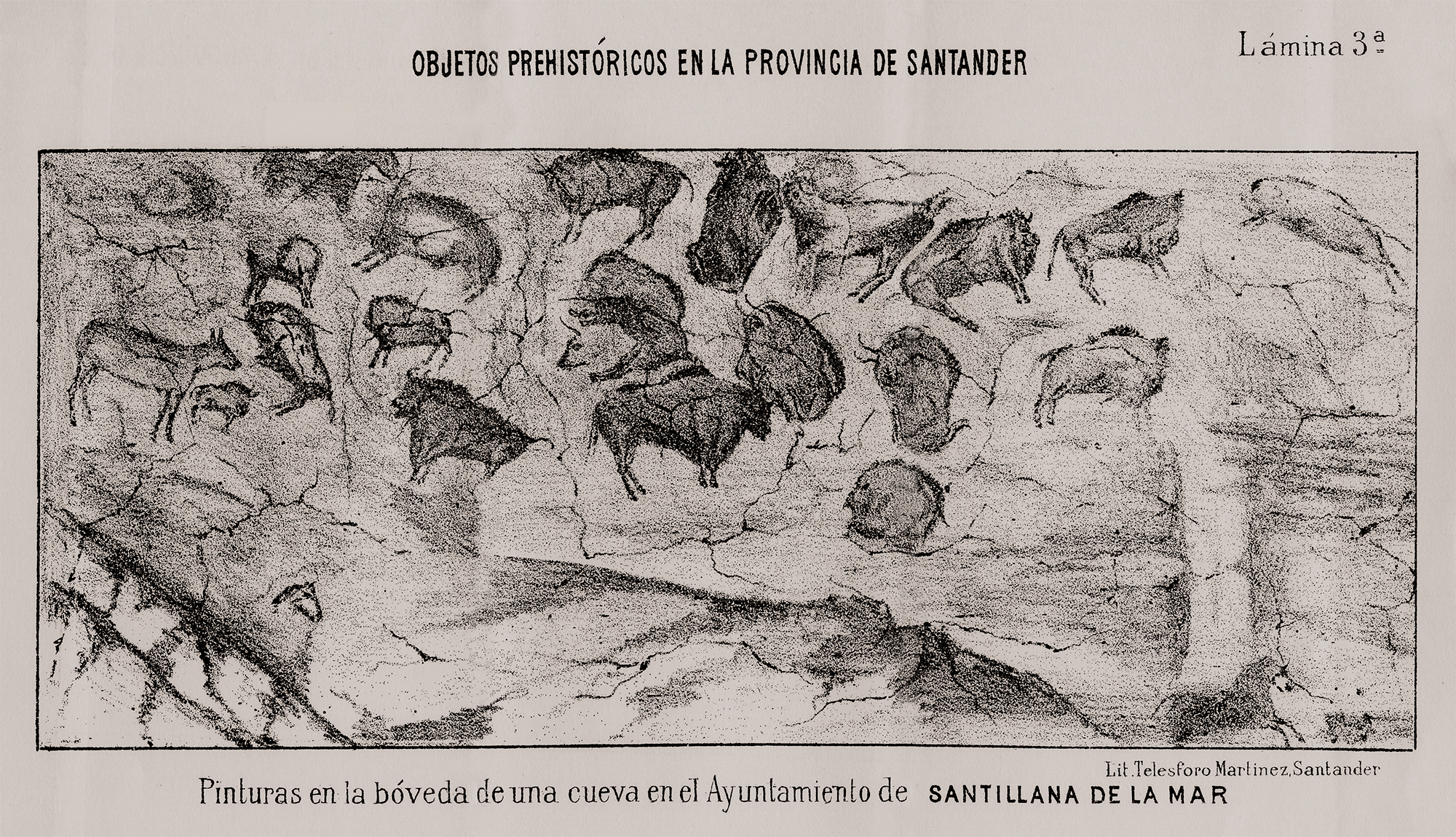
Breves apuntes sobre algunos objetos prehistóricos de la provincia de Santander
A Palaeolithic Airbrush
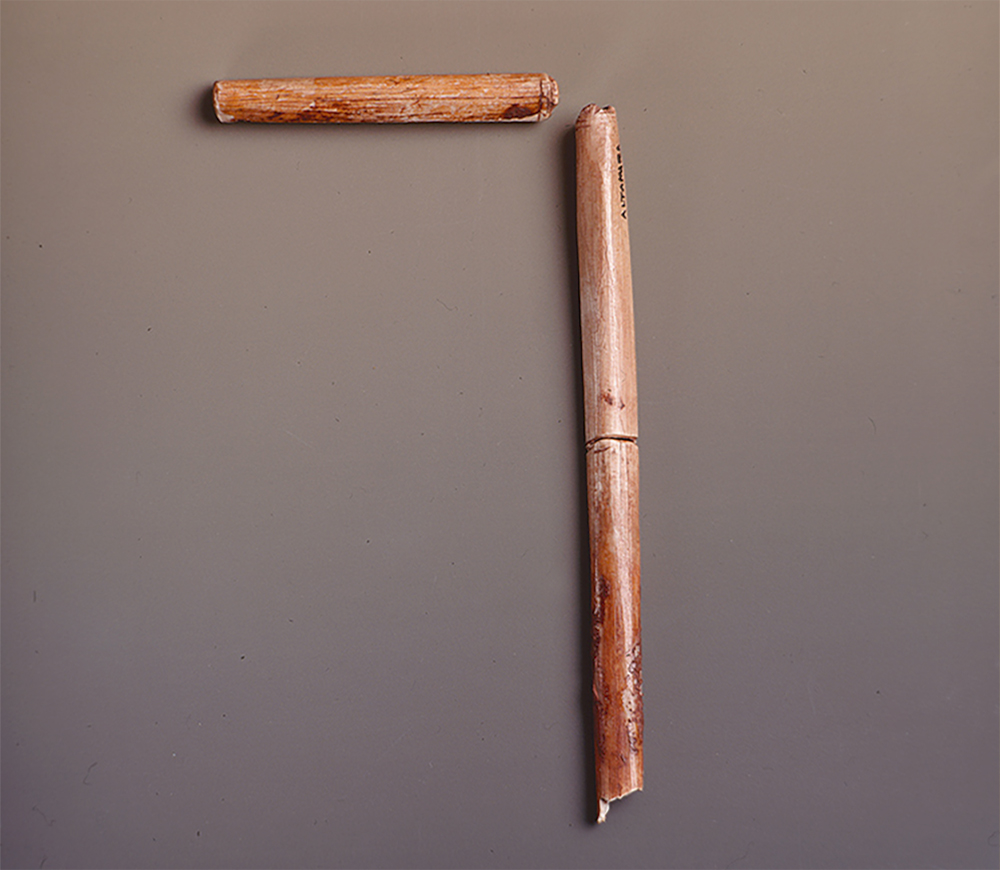
Airbrushes on bird os from the cavern of Altamira
© Museo de Altamira. Photo P. Saura
These airbrushes had gone unnoticed because they were initially catalogued as pendants by Hermilio Alcalde del Río.
The airbrushes were fabricated from iii segments of bones from the leg or fly of a big bird (a raptor or a wading bird). They display de-fleshing and cut marks in the form of transverse grooves. Two of the pieces are at present understood to fit together because they are part of the same os.
Because they exhibit traces of pigment on both outer and inner surfaces, researchers believe them to be tools used to employ ruby liquid paint. The bone pieces would accept been placed at correct angles to each other; by bravado through one section, the other section would blot the pigment and spray it outwards.
Alcalde del Río found these artefacts in crevices in the cavern passage, and thus the lack of further stratigraphic context prevents whatsoever precise dating at this time.
Crimson Deer Scapula
Red deer scapula with two finely-engraved superimposed heads of hinds
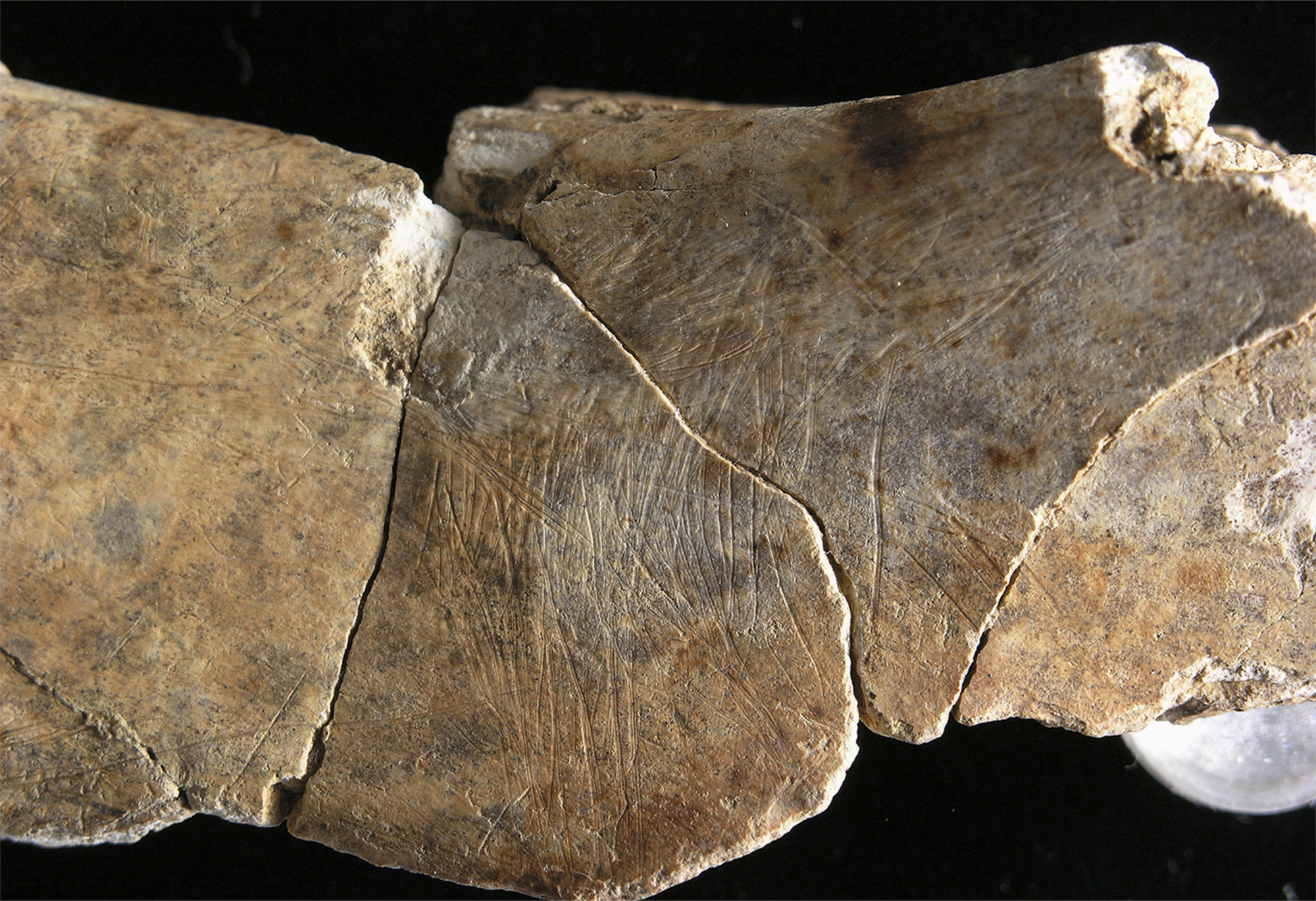
Scapulae with engraved hind
In 2008-2009, an excavation was conducted in the modern entrance of the cavern to decide whether role of the archaeological deposit existed in the area that is now outside the entrance beneath the plummet that blocked it. The cease of an archaeological level measuring 20cm thick was located in the outer limit of the collapse, preserved from the erosive processes that had removed the level in the area adjacent to it. It yielded numerous shells, faunal remains, lithic and bone objects, and a red deer scapula with two finely-engraved superimposed heads of hinds.
This type of engraving is of the same type as those found past Alcalde del Río from 1903 to 1905. The three dates for this level under the plummet place it between xv,370 +/- 60 and fifteen,610 +/- 80 BP, coinciding with Levels 2 to 4 in the interior eolith, in the Lower Magdalenian.
These dates refer to a very precise time, and are of special interest for Altamira as they make the striated engravings of hinds in the cave passages contemporaneous with the polychrome bison on the ceiling in the Hall of the Paintings. Information technology is not possible to determine in which social club the ii kinds of depictions were produced.
Museo de Altamira
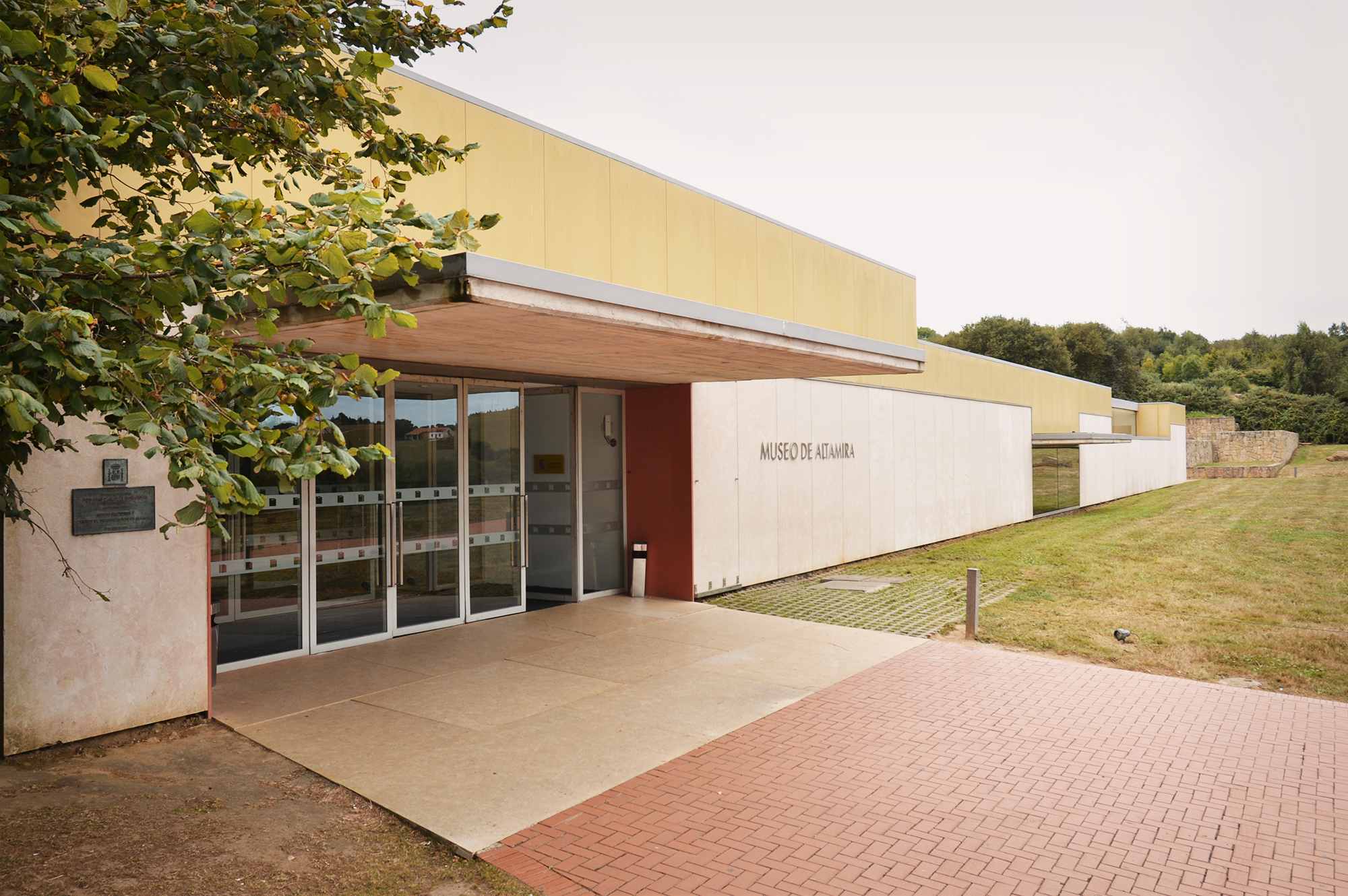
Entrance to Museo Altamira
By Pilar Fatás Monforte, Directora, Museo Nacional y Centro de Investigación de Altamira
The Museum of Altamira is a place devoted to learning about, enjoying and experiencing the life of those who painted and inhabited the cavern of Altamira. The museum's most attractive offer is the possibility of knowing the humanity'southward kickoff art, Paleolithic art.
The Museum is in charge of a legacy of maximum value, the cavern of Altamira, a milestone in universal art history which discovery meant the discovery of Palaeolithic cave art and one of its most spectacular manifestations. The showiness of the artistic expression of the cave'southward inhabitants was recognised by UNESCO, which in 1985 registered it on the Globe Heritage List.
The Neocave of Altamira
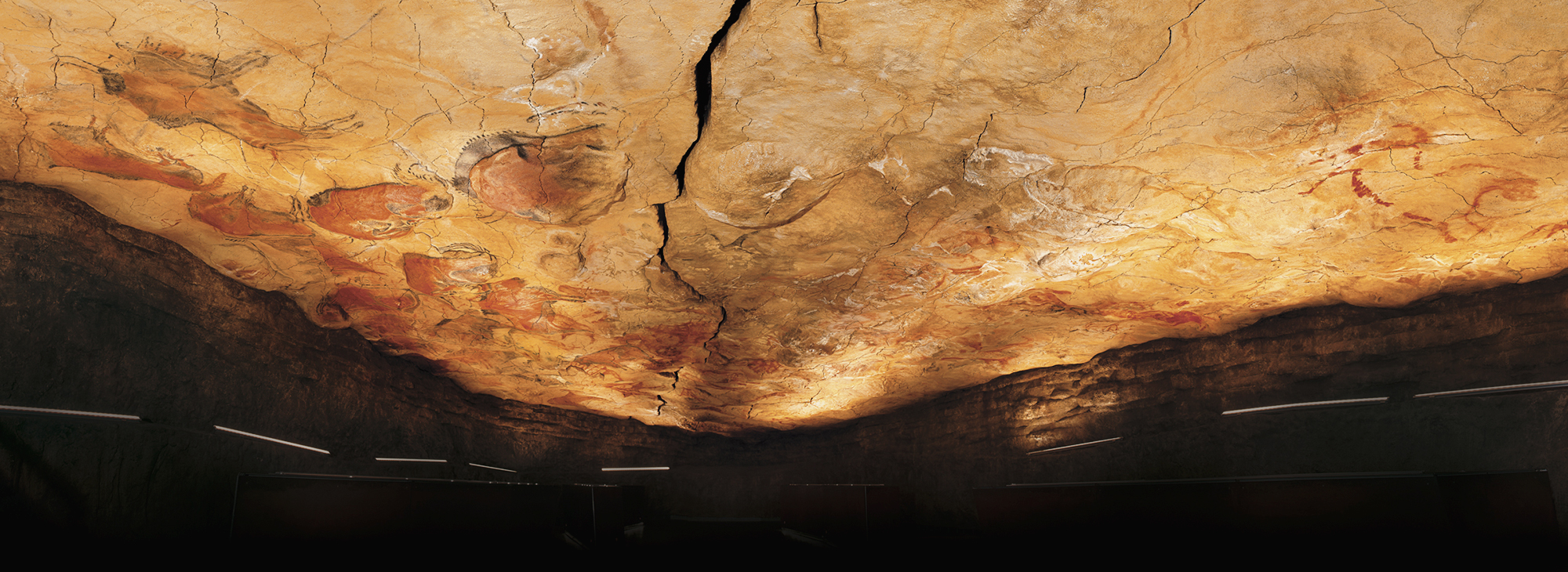
Neocave. Polychrome ceiling
© Museo de Altamira. Photo NXO
The reproduction of the cavern, the Neocave, presents Altamira as a Palaeolithic venue, a habitation site and a sanctuary. This meticulous and exact reproduction, fabricated in full scale, reconstructs the cave of Altamira as it was betwixt 22,000 and 13,000 years ago, when it was inhabited past groups of hunter gatherers. The remains of the everyday life of its inhabitants can be found in the hall expanse, where at that place are large collections of fauna, shells, charcoals, and utensils made out of flint rock, antler and bone, besides as the remains of pigments and objects of furniture that provide data nearly their manner of life.
The fine art surprises the visitor, specially the colorful roof with its bison, horses, deer, goats, and painted and engraved symbols. It is in this role of the cave, scarcely penetrated by daylight, where the spaces of ritual and myth brainstorm. This collection of animals and symbols represents a worldview, the spirituality of the hunters of the Upper Palaeolithic age and the outset of our history.
The art of Altamira stands out on account of the quality of its paintings and engravings, as well as for the diversity of techniques and styles, and the collection of fine art spanning a period of more than twenty k years. It is the most spectacular embodiment of cavern art and constitutes the masterpiece of vivid painters.
The Times of Altamira
'The Times of Altamira' was a research program initiated by the Museum in 2003 to thoroughly examine the archeology of Altamira, both within and out. The program succeeded in reconstructing the history of the cave and consolidating the documentation of its artefact collections. Consequently, research on the archaeological deposit and new dates for the art has contributed towards a new agreement of the Cavern of Altamira.
Of the many artefacts discovered, ii in particular merit attention. A Solutrean and spear point from the cave of Altamira © Museo de Altamira, Photo P. Saura.

The permanent exhibition 'The times of Altamira' gives visitors a closer await at the prehistoric era of the Iberian Peninsula. Dissimilar aspects of prehistoric life in Altamira are shown: art, culture, life, etc.
The life of the hunters and gatherers of the Upper Palaeolithic age is revealed through the archaeological objects on brandish, which take into account their original context and evidence how they were used and created.
Hunters and gatherers satisfied their requirements for survival by selecting natural resources through hunting, fishing and gathering. Part of their daily routine took place within the caves, effectually the fire. Visitors can find out about their diet, the preparation of skins for making clothes and personal ornaments, the organization of the society and its relationship to its surroundings, the economics of exploiting the surrounding environment, seasonal movement throughout the state, and the primary archaeological sites in Cantabria.
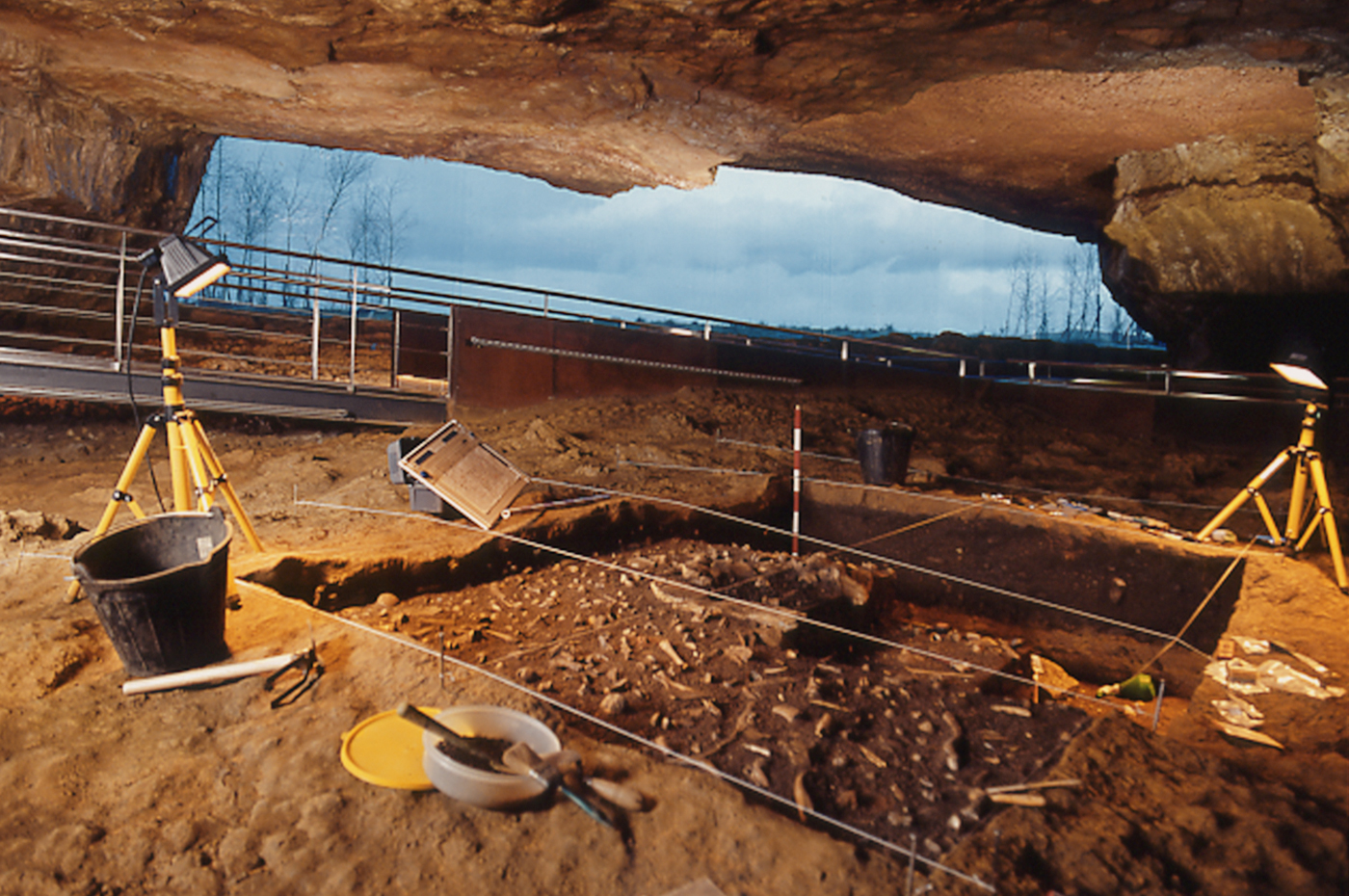
Neocave viewat
the Cave of Altamira
© Museo de Altamira. Photo P. Saura
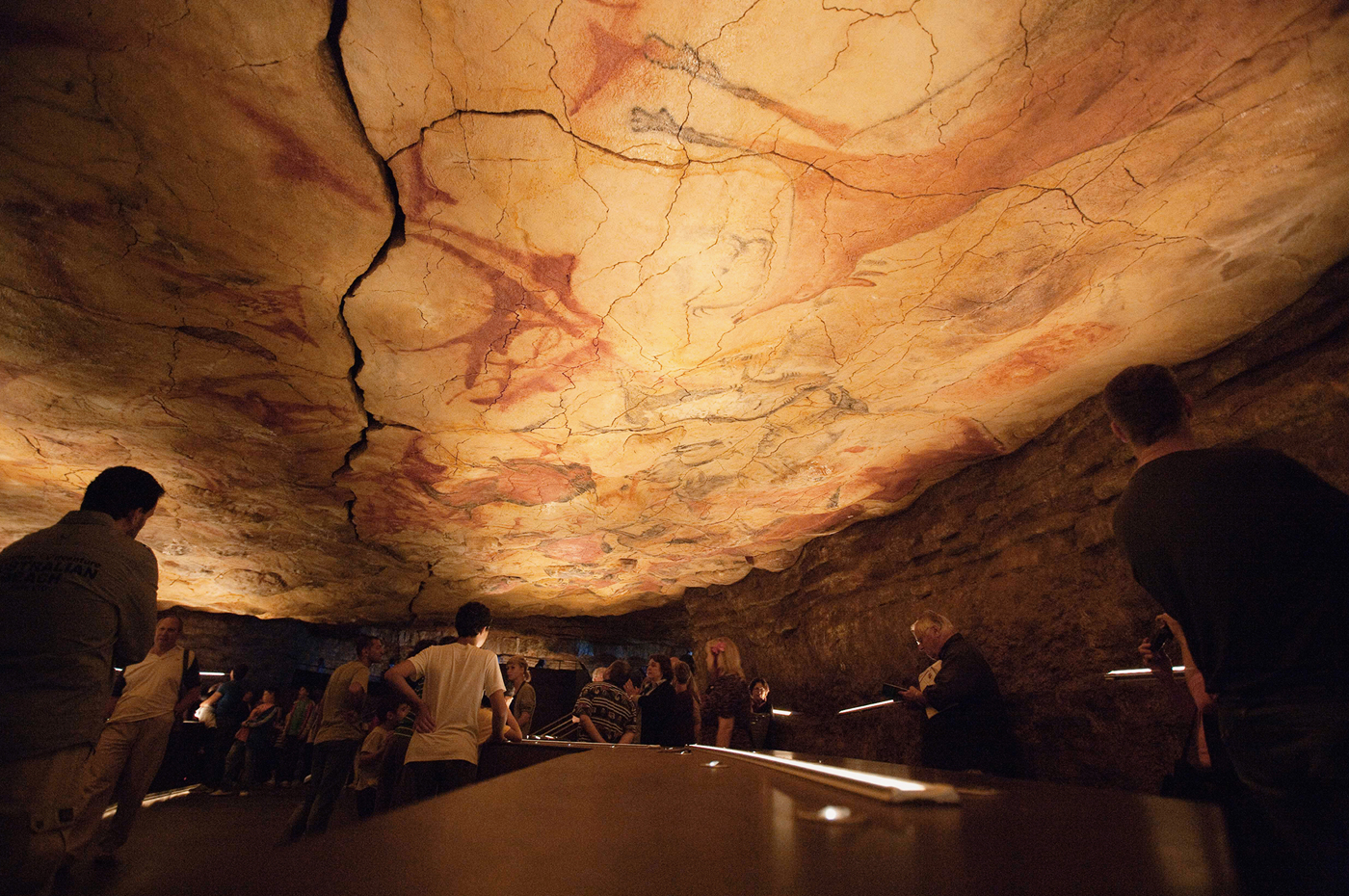
Neocave
Polychrome ceiling
© Museo de Altamira. Photograph V. Gascón
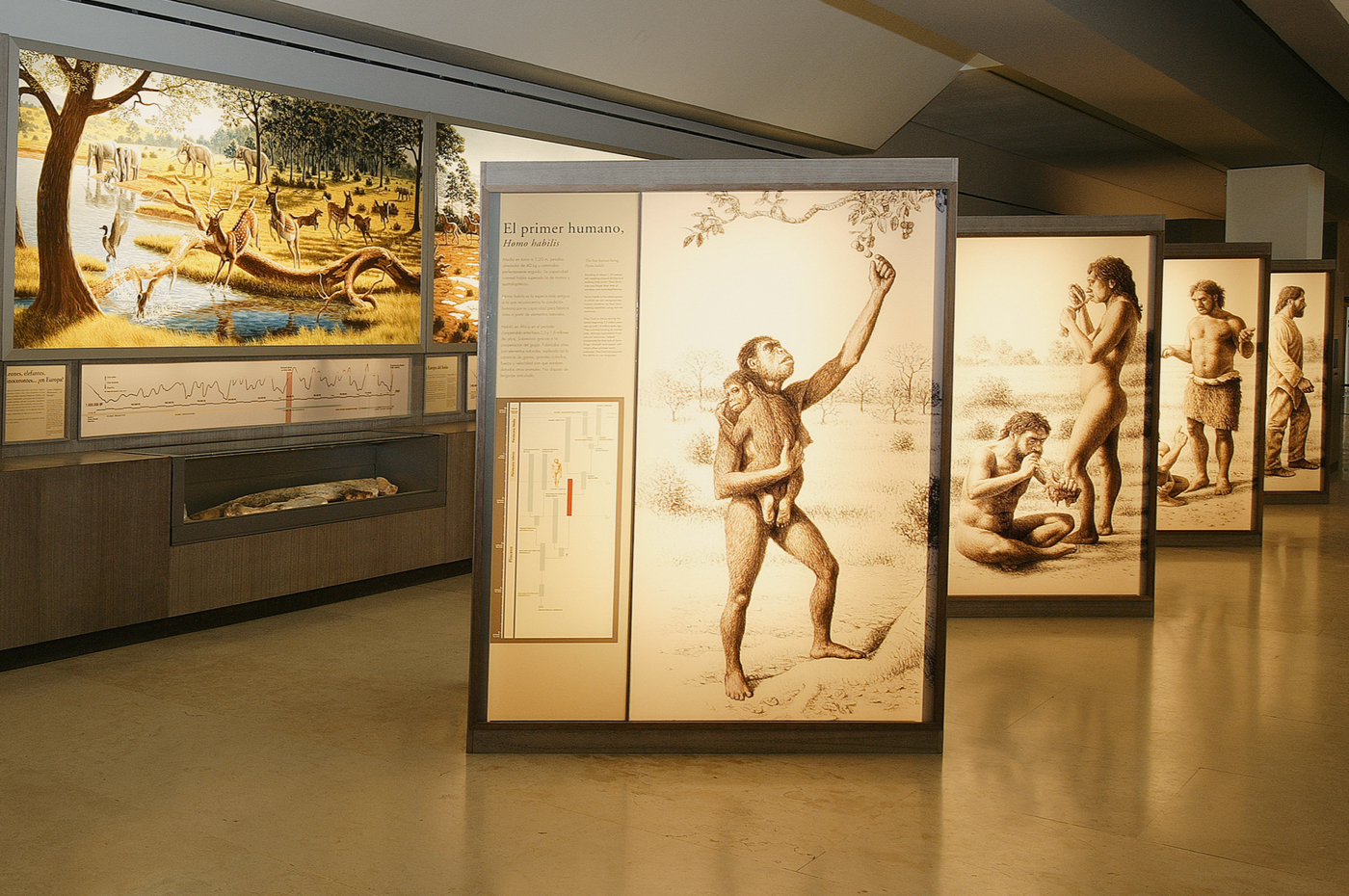
The times of Altamira exhibition
Sector Before Altamira
© Museo de Altamira. Photo M.Otero
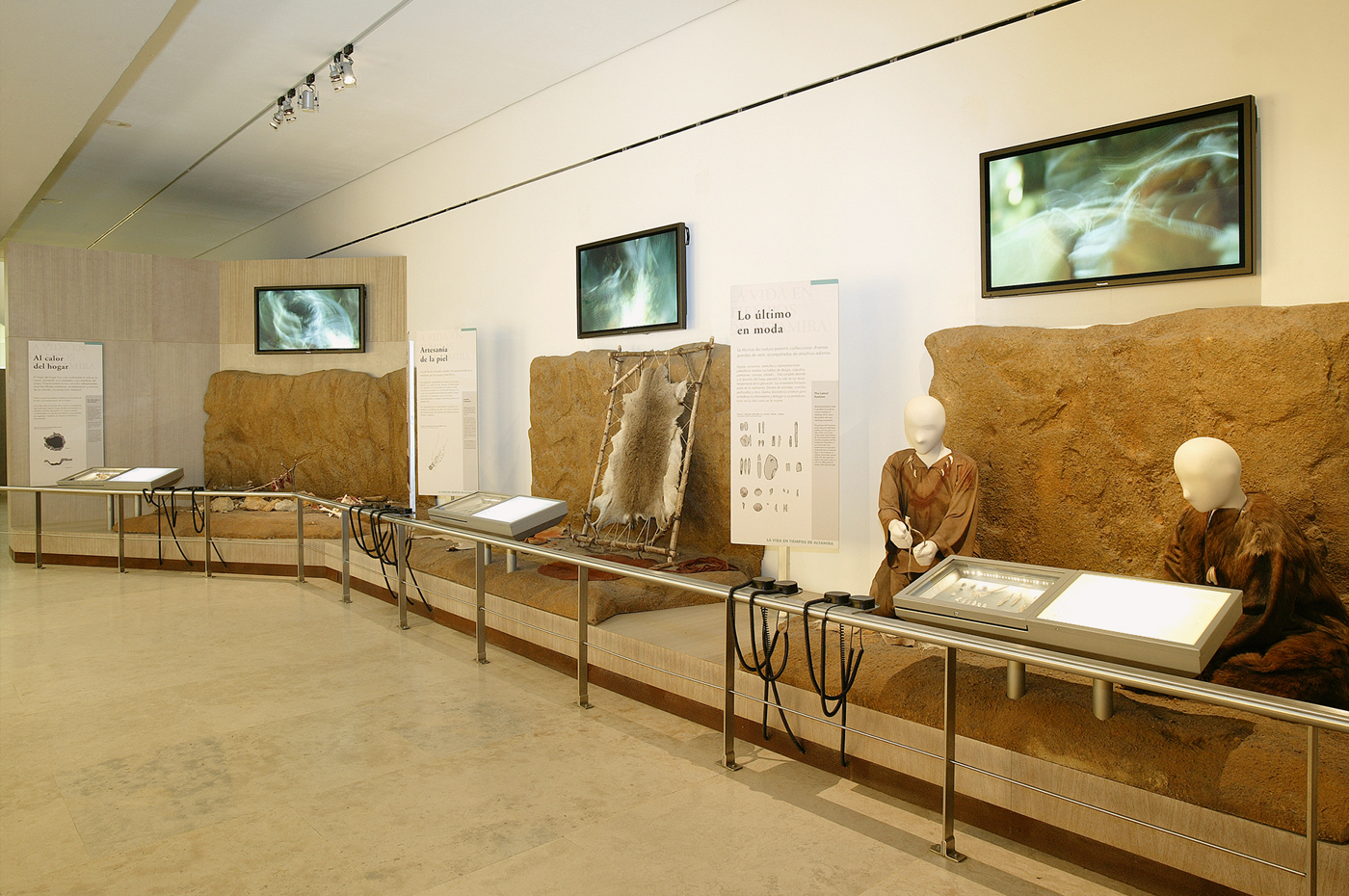
The times of Altamira exhibition
Sector Daily life
© Museo de Altamira. Photo G.Otero
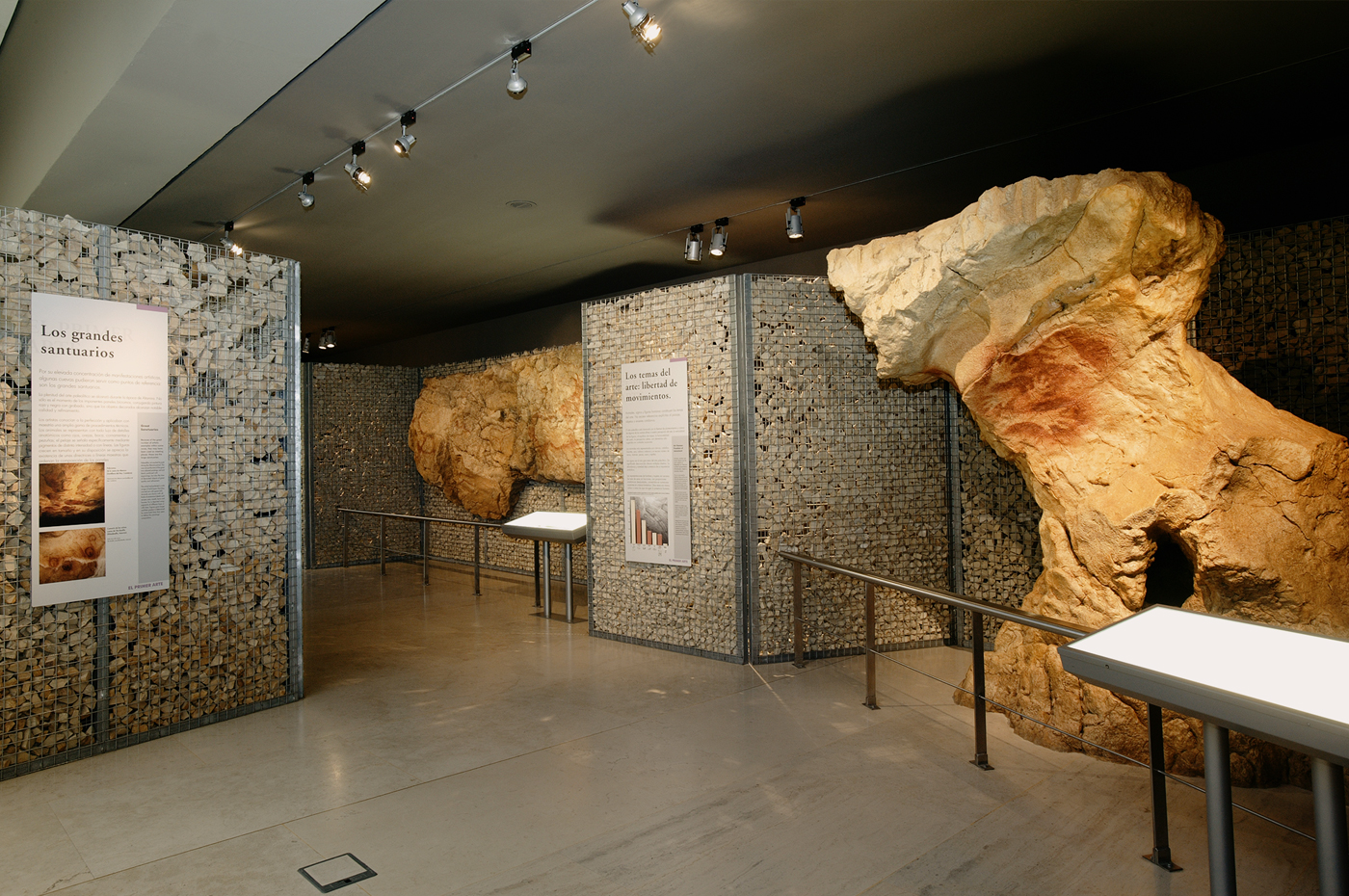
The times of Altamira
exhibition Sector Iv
© Museo de Altamira. Photo M.Otero
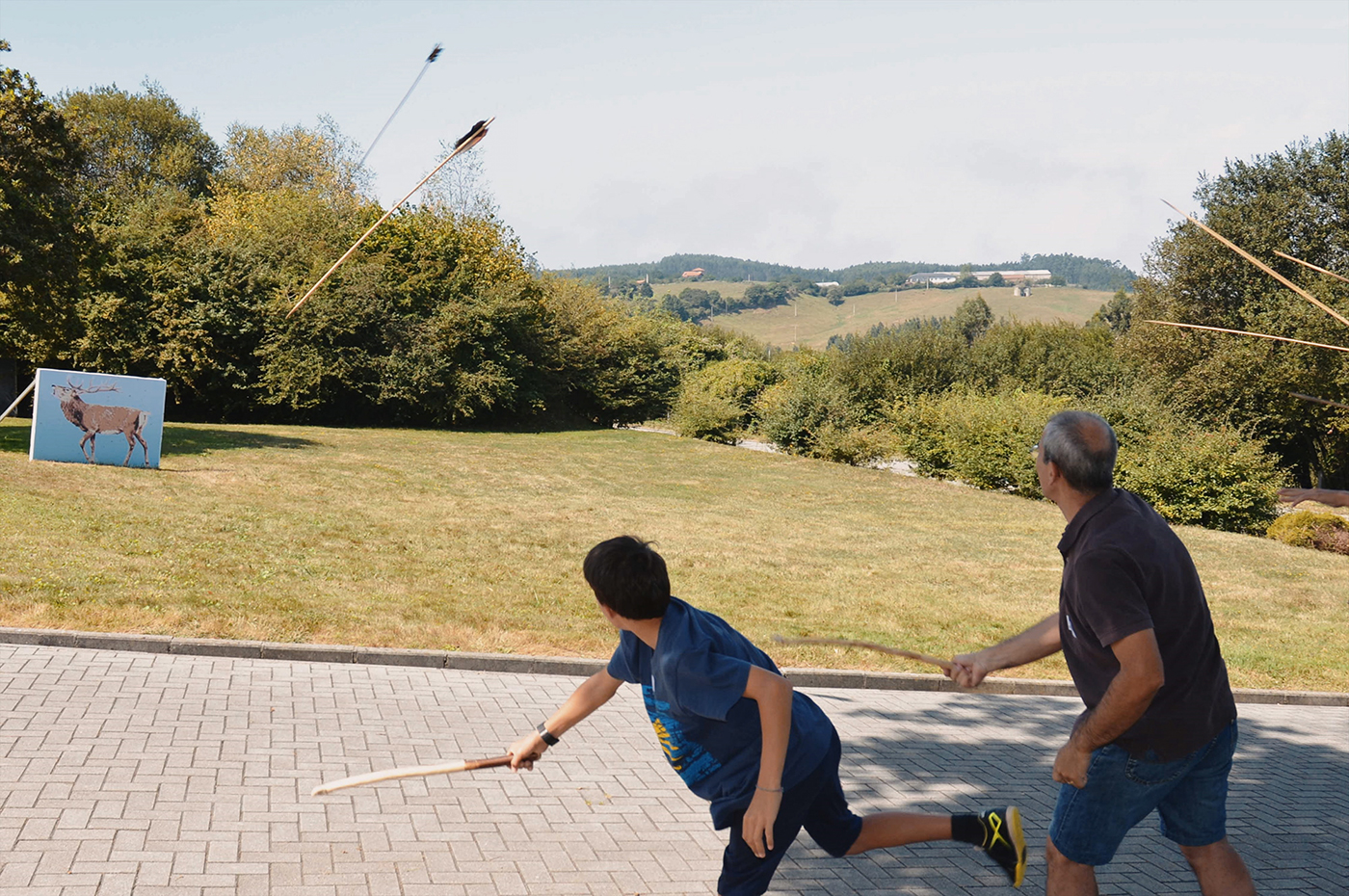
Hunting workshop
at Altamira
Rock Art Network

Pilar Fatás Monforte & Aron Mazel of the Rock Art Network at the cave of Altamira
2019 saw the the third colloquium of the Rock Art Network, organised by Neville Agnew of the Getty Conservation Establish in Los Angeles, consisting of rock art researchers and associated professionals from around the globe. Information technology followed on from the ii previous colloquia: the 2017 Namibia colloquium 'Art on the Rocks - A Global Heritage' and the 2018 United States colloquium 'Fine art on the Rocks - Developing action plans for public and professional networking' held in California and Texas. The 2019 French republic and Spain colloquium 'Replication as Conservation: Chauvet, Lascaux, Altamira' held presentations and discussion groups, interspersed with visits to caves and cavern replicas.
At the Museum of Altamira - Museo Nacional y Centro de Investigación de Altamira - located abreast the Cave of Altamira, the group was hosted by the museum'south Manager Pilar Fatás, herself a member of the Rock Art Network.

The Rock Fine art Network at the cave of Altamira
The Museum of Altamira is a splendidly designed edifice devoted to learning of, enjoying and experiencing the life of those who painted and inhabited the cavern of Altamira. The reproduction of the cavern - the Neocave - presents Altamira equally a Palaeolithic venue, a dwelling house site and a sanctuary. This meticulous and verbal reproduction, made in total scale, reconstructs the cavern of Altamira as it was betwixt 22,000 and xiii,000 years ago, when it was inhabited by groups of hunter-gatherers. The remains of everyday life of its inhabitants tin can be plant in the museum's exhibition area, where there are large collections of fauna, shells, charcoals, and utensils fabricated out of flintstone rock, antler and bone, as well as the remains of pigments and objects of furniture that provide information about their way of life.
'Colour and ability: stone fine art of San hunter gatherers in Ukhahlamba-Drakensberg'. The visit coincided with the new exhibition at the Museum of Altamira, displaying images of the cave paintings of Ukhahlamba-Drakensberg - which has the greatest concentration of this blazon of art - also every bit objects of the San material civilisation. The exhibition is the result of collaboration between 2 members of the Stone Art Network, our host Pilar Fatás and Aron Mazel, archaeologist and researcher at the University of Newcastle in Britain.
Source: https://www.bradshawfoundation.com/spain/altamira/index.php
0 Response to "What Preserved the Art of Altamira Until Modern Day"
Enregistrer un commentaire